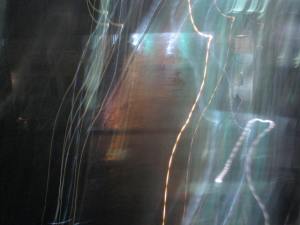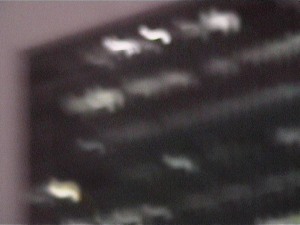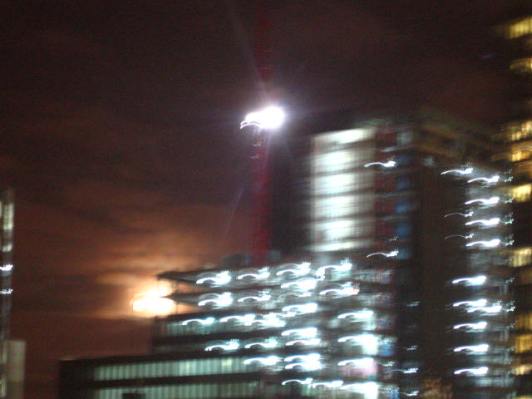The title of this blog is also the name of a Lucinda Williams song from the album, Car Wheels on a Gravel Road, where various characters from places in the USA ask how this wall can be real. Back in Algiers, down in Opelousas and somewhere in Louisiana, strong hands or mean dogs can’t break down or move the wall which, although it divides us on two different sides, is not what it seems – after all, it’s only made of concrete and barbed wire. The song could become a kind of anthem and have several applications, material, philosophical or ideological. In fact ‘the wall’ has been a potent subject for many international contemporary artists.

For example, Palestinian artist Emily Jacir’s video work, Crossing Surda (2003) concerns forms of exclusion and identity, focusing on the stressful realities of everyday movement crossing armed checkpoints in Ramallah. The work depicts a landscape of concrete barriers, tanks and dirt roads in what has been described by Palestinian poet, Mahoud Darwish as a condition of ‘near distance’.
Photographer Sophie Ristelhueber’s work investigates concepts of territory and devastation. Her images of disfigured landscapes from Kuwait, Bosnia and Iraq of bomb craters and blasted buildings can be considered, according to her book Operations (2009) as scars of conflict and a metaphor for a universal ‘terrain of emotions’.

These works reflect WJT Mitchell’s view that despite contemporary tools and technologies such as Google Earth and GPS, the world has actually become more invisible and inscrutable and in a state of entrenched terra incognita of antagonism. Perhaps what is needed is a renewed consciousness of space through performance. I speculated on a revised Group Material response via a site-specific performance-as-intervention; or what artist and writer, Coco Fusco has proposed as interrogation via a series of instructional drawings. Through the development of an ongoing oppositional public sphere, I suggest that this Lucinda Williams’ song could be brought to serve as a form of laboratory theatre: stuck on repeat and staged within different environments when needed. Ideally it would function as a collaborative performative intervention, critiquing how we perceive and experience the world, drawing our attention to issues of repudiation and power.
 Philosopher Michel Foucault saw power itself as embedded within an ubiquitous network which runs throughout the social and cultural body, inducing both pleasure and forms of knowledge. In Discipline and Punish (1980), he proposes the central tower as the all-seeing architectural figure which functions as a mechanism of control and regulation. This supervisory restraint is absorbed as a method of self-control in modern societies, reaching into the ‘very grain of individuals…touching their bodies and inserting itself into their attitudes and everyday lives’. Strategic interventions into this indeterminate ‘play of powers’, Foucault considered as part of a rationale for resistance.
Philosopher Michel Foucault saw power itself as embedded within an ubiquitous network which runs throughout the social and cultural body, inducing both pleasure and forms of knowledge. In Discipline and Punish (1980), he proposes the central tower as the all-seeing architectural figure which functions as a mechanism of control and regulation. This supervisory restraint is absorbed as a method of self-control in modern societies, reaching into the ‘very grain of individuals…touching their bodies and inserting itself into their attitudes and everyday lives’. Strategic interventions into this indeterminate ‘play of powers’, Foucault considered as part of a rationale for resistance.
 Another song by Lucinda Williams from the same album always seems to me to be evocative of an Ed Kienholz installation of the 1960s. Its scene is set in a ‘dirty little joint’ where there’s no good or no bad and where house rules apply with no exceptions: no bad language, no gambling, no fighting and no credit (so don’t ask). A figure sits in the corner by the bar who ‘sold his soul to the devil, so he could play guitar’. This, I propose can be considered as a form of ‘song sculpture’: like Kienholz’ assemblaged scenes, it conjures a form of tableau where other figures, as Claire Bishop has observed, are ‘immersed on our behalf’. The viewer / listener is at a distance and becomes the absent onlooker of the everyday, but somehow disturbing, scene. (The bar is a trope for a particular ennui of modernity: see for example Edward Hopper and Patrick Caulfield).
Another song by Lucinda Williams from the same album always seems to me to be evocative of an Ed Kienholz installation of the 1960s. Its scene is set in a ‘dirty little joint’ where there’s no good or no bad and where house rules apply with no exceptions: no bad language, no gambling, no fighting and no credit (so don’t ask). A figure sits in the corner by the bar who ‘sold his soul to the devil, so he could play guitar’. This, I propose can be considered as a form of ‘song sculpture’: like Kienholz’ assemblaged scenes, it conjures a form of tableau where other figures, as Claire Bishop has observed, are ‘immersed on our behalf’. The viewer / listener is at a distance and becomes the absent onlooker of the everyday, but somehow disturbing, scene. (The bar is a trope for a particular ennui of modernity: see for example Edward Hopper and Patrick Caulfield).
A form of scene-setting is being explored by a current MA Fine Art sculpture student who manipulates the placement of miniature figures of the kind used in the design of architecture models, in relation to found objects to create unsettling scenarios. In a recent exhibition in a new gallery in Folkestone, he installed a large, 3m x 2m block of found polystyrene packaging which he hacked into two asymmetrical sections. The larger part stood nakedly alone, projecting a dominant presence in the small gallery space. The surface of its white, seemingly perfect but pocked-marked body was reminiscent of refrigeration or meat packaging: trails and smears of dark brown streaks powerfully suggested a history of blood and violence.
In a recent exhibition in a new gallery in Folkestone, he installed a large, 3m x 2m block of found polystyrene packaging which he hacked into two asymmetrical sections. The larger part stood nakedly alone, projecting a dominant presence in the small gallery space. The surface of its white, seemingly perfect but pocked-marked body was reminiscent of refrigeration or meat packaging: trails and smears of dark brown streaks powerfully suggested a history of blood and violence.
The other (smaller) section stood nearby, its flat end to the floor. On its hewn, uneven, white surface was placed a miniature figure, becoming a desolate Arctic landscape, persuasively evoking the ultimate isolation and futility of life, in a version of a man-against-nature scenario. The two works summoned a metaphor for human experience and struggle evidenced by the tracks, scars, scratches and stains of the larger piece and its overwhelming scale; and the barrenness of the ‘snowy’ landscape’s ‘non- geography’ which seems to submerge the tiny protagonist in the smaller work. The sculptures’ intrusive effects in the gallery appeared to be recognized by viewers of the exhibition, triggering hostile reactions. According to the invigilators, one individual came repeatedly every day to rant angrily about it.
 There was something about the use of packaging as material for sculpture that had a resonance with Folkestone as a port which had gone into decline since containerization in the 1980s. The packaging, once itself a form of container, becomes ironically site-specific: now discarded and non-degradable.
There was something about the use of packaging as material for sculpture that had a resonance with Folkestone as a port which had gone into decline since containerization in the 1980s. The packaging, once itself a form of container, becomes ironically site-specific: now discarded and non-degradable.
The same student is a JG Ballard fan, in particular of the 1974 novel, Concrete Island, where, through a series of misguided decisions, the protagonist becomes stranded in a section of fenced-off wasteland in the middle of a motorway intersection. In a recent discussion about practice, the student described a wire fence that he was trying to get hold of that surrounded the derelict Dreamland funfair site in Margate. The fence had been trampled and flattened in parts over years and was mostly set in concrete below ground level. It failed to keep out trespassers but was impossible to remove: whenever the student tried to pull a part out, a security guard appeared from nowhere.

As Adrian Forty (Concrete and Culture, 2012) has observed, concrete is a potent material in our understanding of time and materiality. It is both unclassifiable (neither simply stone, plaster nor iron) and transformative (materially and socially). Associated mainly with architecture and modernism, concrete nevertheless induces ambivalence. Like Richard Serra’s text-drawing, Verb List (1967) its technical and material possibilities are versatile and potentially endless. Paradoxically associated with efficiency and brutality, aesthetic cool and demolition rubble, concrete embodies, according to Forty, our profound discomfort with modernity. Le Corbusier’s use of ‘rough concrete’ as an aesthetic form has echoes in London’s post-war buildings from the South Bank to the Barbican where students of architecture gather to study the hammered concrete surfaces of the support pillars.
 The internal struggle to come to terms with change through processes of dereliction and renewal has an obvious relationship to art – both in subject and method. In the catalogue to the exhibition of Frank Auerbach’s drawings and paintings of London building sites from 1952-62 held at the Courtauld Gallery in 2010, Barnaby Wright reflects on Auerbach’s own experience and survival of war, his process of painterly destruction in the ‘thick, obliterated and reworked surfaces’ and the city’s devastation and rebirth through construction after the Second World War. He saw in the bomb sites a landscape of formal drama and precipitous mountain crags where survivors scurried among the ruins.
The internal struggle to come to terms with change through processes of dereliction and renewal has an obvious relationship to art – both in subject and method. In the catalogue to the exhibition of Frank Auerbach’s drawings and paintings of London building sites from 1952-62 held at the Courtauld Gallery in 2010, Barnaby Wright reflects on Auerbach’s own experience and survival of war, his process of painterly destruction in the ‘thick, obliterated and reworked surfaces’ and the city’s devastation and rebirth through construction after the Second World War. He saw in the bomb sites a landscape of formal drama and precipitous mountain crags where survivors scurried among the ruins.
Relevant Links:
Emily Jacir; Sophie Ristelhueber; Michel Foucault Discipline and Punish; Turner Contemporary; Frank Auerbach Building Sites; JG Ballard; MA Fine Art Canterbury

